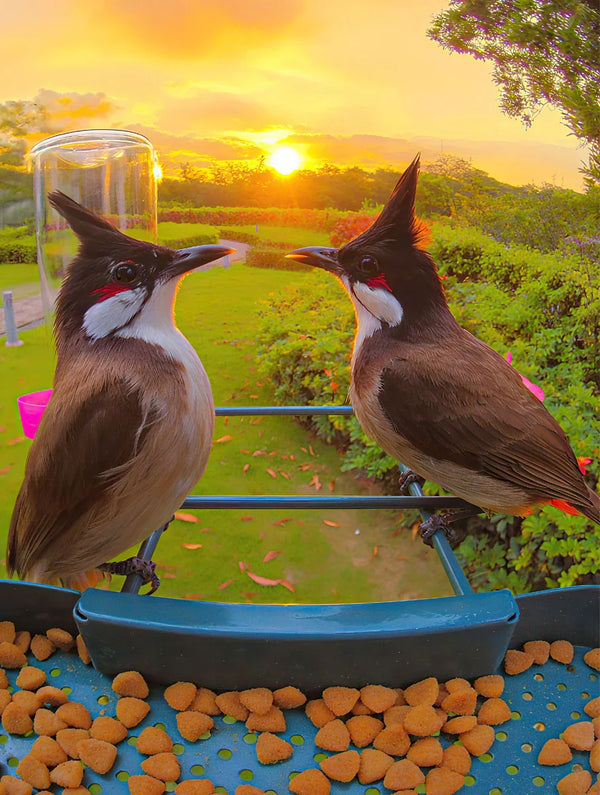Unlock the Secrets to Attracting Beautiful Birds with Your Perfect Feeder Setup!
Setting up a bird feeder is one of the most rewarding ways to bring nature into your backyard. Not only does it provide food for our feathered friends, but it also offers a delightful spectacle for birdwatchers of all ages. Imagine sipping your morning coffee while watching a vibrant cardinal pecking at seeds or a cheerful finch fluttering about. Bird feeders can transform a mundane garden into a lively habitat that attracts a variety of species. Additionally, feeding birds supports local wildlife, helping to sustain their populations and allowing you to contribute positively to your ecosystem. Whether you're a seasoned birdwatcher or a curious beginner, understanding how to effectively set up a bird feeder setup can enhance your experience and foster a deeper connection with nature.

Understanding Bird Feeders
Bird feeders come in various shapes and sizes, each designed to cater to different species and feeding behaviors. Tube feeders are ideal for small, perching birds like finches and chickadees, as they provide a secure place to perch while they eat. Platform feeders, on the other hand, are more versatile and can accommodate larger birds, such as doves and jays, as well as ground feeders. Suet feeders are specifically designed for high-energy food cakes, attracting woodpeckers and nuthatches. Each type of feeder has unique features that can enhance your backyard's birdwatching potential. For instance, a mesh feeder allows smaller birds to cling while eating, whereas a closed feeder helps protect the food from squirrels. Understanding these nuances can help you select the right feeder to attract the birds you desire.
Choosing the Right Location
Once you've selected your bird feeder, the next step is to find the perfect location. Visibility is key; you want to be able to enjoy watching the birds without disturbing them. Place your feeder near a window or a patio where you can easily observe the activity. However, it’s also important to consider safety from predators. Try to position your feeder near natural shelter, like bushes or trees, where birds can quickly escape threats. Additionally, avoid placing feeders too close to areas where cats roam, as this can create a dangerous environment for the birds. A distance of at least 10 feet from cover is recommended to ensure the birds can safely access the feeder while still having a quick escape route. Creating a harmonious setup increases the chances of attracting a diverse array of birds to your backyard.
Selecting the Best Bird Food
The type of food you offer is crucial in attracting specific bird species. For instance, sunflower seeds are a favorite among many birds, including cardinals and chickadees, while nyjer (thistle) seeds appeal to finches. If you want to attract woodpeckers, consider offering suet cakes made from rendered animal fat mixed with seeds and fruits. It's also beneficial to provide a variety of food types, as this can cater to different birds while keeping your feeding area bustling. As my friend Emma discovered, using a mix of seeds led to a delightful surprise when she spotted a rare species visiting her feeder. She learned that offering diverse food options not only attracts more birds but also creates exciting opportunities for birdwatching. Always remember to research the dietary preferences of the birds you wish to attract, ensuring you provide the most appealing options.
Setting Up Your Bird Feeder
Now that you have your feeder and food, it’s time to set it up properly. Start by selecting a stable mounting technique. If you're using a pole-mounted feeder, ensure it's securely anchored into the ground, ideally about 18 inches deep, to withstand wind and potential disturbances. If you're placing the feeder on a tree branch or a hook, make sure it's at a height where the birds can access it easily, but also out of reach of potential predators. For platform feeders, consider using a tray with drainage holes to prevent moldy food. Once your feeder is mounted, fill it with your chosen bird food and observe how the birds interact with their new dining area. Remember to keep it at least five feet off the ground to discourage unwanted visitors and make it easier for birds to feed. Proper installation is key to ensuring a safe and enjoyable feeding experience for your feathered guests.
Maintenance Tips for Your Bird Feeder
Regular maintenance is essential for keeping your bird feeder a safe and welcoming environment. Start by cleaning the feeder every few weeks, especially after periods of heavy rain or if you notice any mold or clumping of food. A simple mixture of warm water and mild soap will suffice; just be sure to rinse thoroughly to remove any residue. Additionally, check the food level regularly and refill as necessary to avoid empty feeders, which can discourage returning birds. Keep an eye out for pests, such as ants or squirrels, and take measures to deter them if they become a problem. My friend Alex learned this the hard way when he found his feeder raided by squirrels. He quickly adapted by adding a baffle to the pole, which solved the issue. Consistent upkeep not only ensures a healthy feeding environment but also enhances the joy of birdwatching by keeping your feathered friends coming back for more.
Final Thoughts on Your Bird Feeding Journey
Setting up your bird feeder is a rewarding endeavor that can bring joy and beauty to your garden. By understanding the types of feeders, choosing the right location, selecting appropriate food, and maintaining your setup, you can create a thriving habitat for birds. The sight of colorful birds flitting about your yard is not only a treat for the eyes but also a step towards supporting local wildlife. So gather your supplies, follow these tips, and embark on your bird-feeding journey today. The rewards of attracting beautiful birds are truly endless, offering a unique blend of relaxation and the thrill of discovery every time you step outside.








